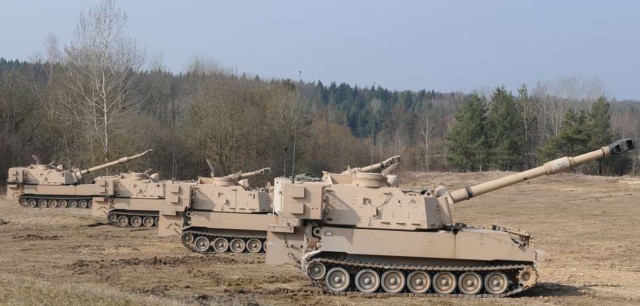On January 6, 2023, the US Department of Defense announced the allocation of a new, the largest one-time package of US military assistance to Ukraine in the amount of $ 3.075 billion so far. The central part of the new aid package was the provision of 50 M2 Bradley infantry fighting vehicles to Ukraine for the first time. For the first time, a number of other weapons are also distinguished. The total amount of US military assistance officially allocated to Kiev since the beginning of the Russian special military operation in Ukraine on February 24, 2022 now amounts to more than $ 24.9 billion, and the total amount of US military assistance to Ukraine since 2014 has exceeded $ 27 billion.

155-mm/39 self-propelled howitzers M109A6 Paladin of the U.S. Army during a shooting practice at the range in Greifswald (Germany), 03/23/2015 (c) U.S. ArmyThe new package of military assistance to Ukraine is divided into two parts.
The first part represents the allocation of a record $ 2.85 billion by the orders of the US President within his administrative powers (Presidential Drawdown of Security Assistance - PDA) and is an operational allocation of property from the presence of the US Department of Defense. This is the 29th and largest presidential package of military assistance to Ukraine under the PDA since August 2021.
In addition, another $225 million has been allocated to Ukraine through Foreign Military Financing (FMF) and these funds are intended to finance long-term development projects of the armed forces of Ukraine.
At the same time, it was announced that Foreign Military Financing (FMF) would allocate another 682 million dollars to other Eastern European countries, mainly for projects to co-finance their purchases of American weapons.
Under the PDA line, this new package of military assistance to Ukraine provides:
- 50 M2 Bradley infantry fighting vehicles and 500 TOW anti-tank guided missiles and 250 thousand rounds of 25 mm caliber;
- an unnamed additional number of GMLRS precision guided missiles for HIMARS missile systems;
- 100 tracked M113 armored personnel carriers;
- 55 MRAP class wheeled armored vehicles of unspecified type;
- 138 HMMWV cars;
- 18 155 mm self-propelled howitzers and 18 armored ammunition transport vehicles (other sources report that these will be 155 mm/39 M109A6 Paladin self-propelled howitzers, and, apparently, respectively, M992A2 FAASV armored ammunition transport vehicles on the same base);
- 70 thousand artillery rounds of 155 mm caliber;
- 500 high-precision artillery shots of 155 mm caliber (apparently M982 Excalibur);
- 1200 155 mm cluster shells of the Remote Anti-Armor Mine (RAAM) remote mining system (with anti-tank mines);
- 36 towed howitzers of 105 mm caliber (probably M119) and 95 thousand artillery rounds of 105 mm caliber;
- 10 thousand 120 mm mortar shells;
- an unnamed number of RIM-7 Sea Sparrow anti-aircraft guided missiles;
- 4000 unguided aircraft missiles Zuni caliber 127 mm;
- about 2,000 hand-held anti-tank grenade launchers;
- sniper rifles, machine guns and ammunition for automatic anti-personnel grenade launchers and small arms;
- Claymore directional anti-personnel mines;
- night vision devices and optical devices;
- spare parts and other field equipment.
As already mentioned, 50 M2 Bradley infantry fighting vehicles are provided to Ukraine for the first time in this package. It is also worth noting the provision of a number of other weapons to the Ukrainian side for the first time:
- 155 MM/39 SELF-PROPELLED HOWITZERS M109A6 Paladin;
- old RIM-7 Sea Sparrow anti-aircraft guided missiles - as already reported, they should be used from self-propelled launchers of the Soviet Buk-M1 air defense system that were in service with the AFU. As already noted on the blog, the use of old American ship-based Sea Sparrow medium-range missiles with a semi-active radar guidance system for the Ukrainian Buk-M1 air defense system represents a resolution of the issue with the ammunition of missiles for the armed forces of Ukraine, since modern Western missiles (such as AIM-120 AMRAAM) are obviously too expensive and scarce for use in the fighting in Ukraine on the necessary scale. At the same time, the United States obviously has large reserves of missiles from the obsolete Sea Sparrow naval air defense system being decommissioned. Raytheon Corporation has been working for a long time, since the beginning of the 2000s, to adapt the Sparrow family of missiles with a semi-active radar guidance system to the Soviet air defense system "Cube" ("Square"), previously actively offering this combination to Eastern European countries operating the air defense system "Cube", although in the end it did not receive serial status. Apparently, the current version of the integration of the Sea Sparrow missiles on the Buk-M1 air defense system is a development of these works.
- old 127-mm unguided Zuni aircraft missiles - in 2006-2012, the American branch of the European association MBDA, together with the US Navy, worked on the Laser-Guided Zuni Rocket project to create a guided version of the Zuni rocket with a laser semi-active guidance system. Although this version of the Zuni was successfully tested, however, data on its serial production and entry into service were still missing from any operators. It can be assumed that Ukraine will be supplied with Zuni missiles in a controlled version, including, possibly, for launching from ground-based launchers.
